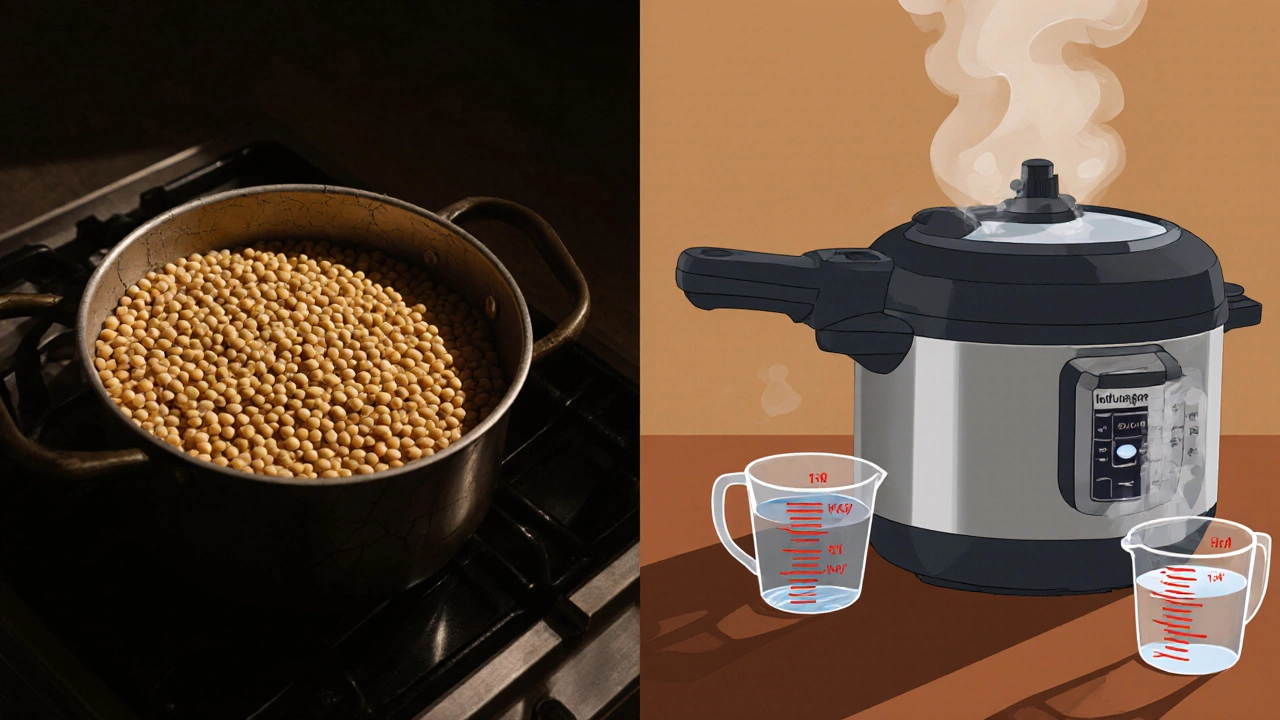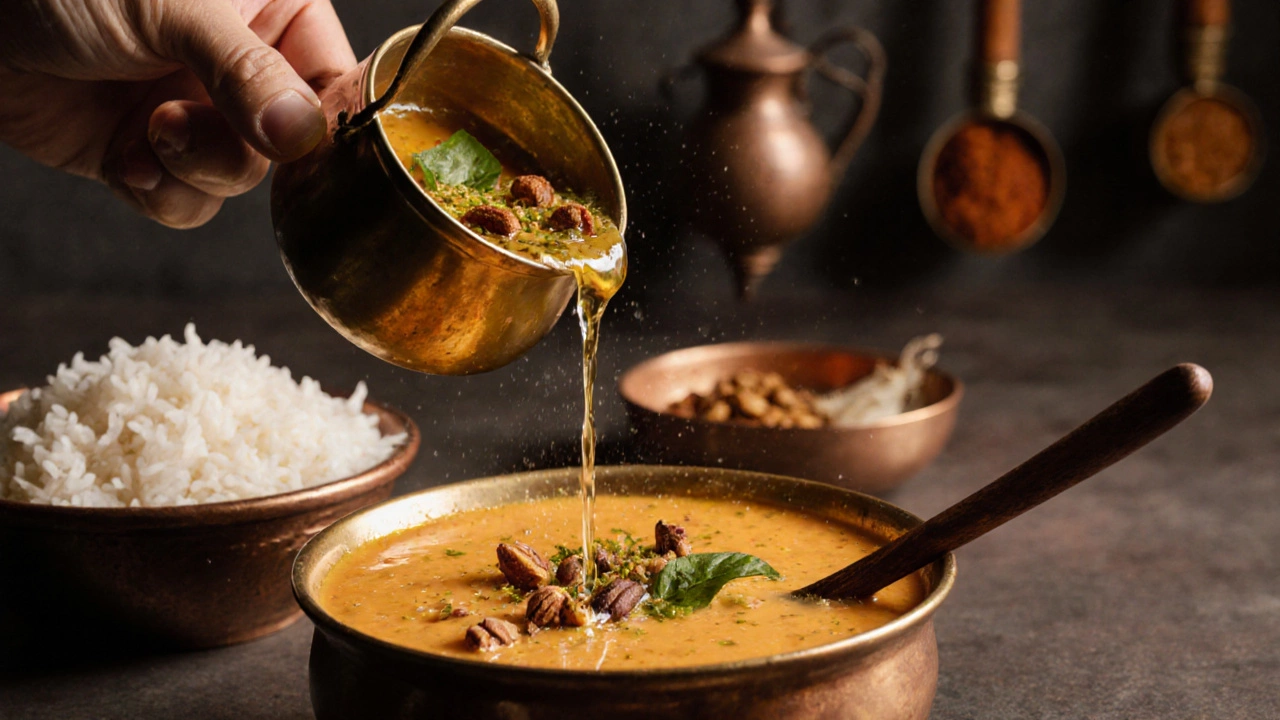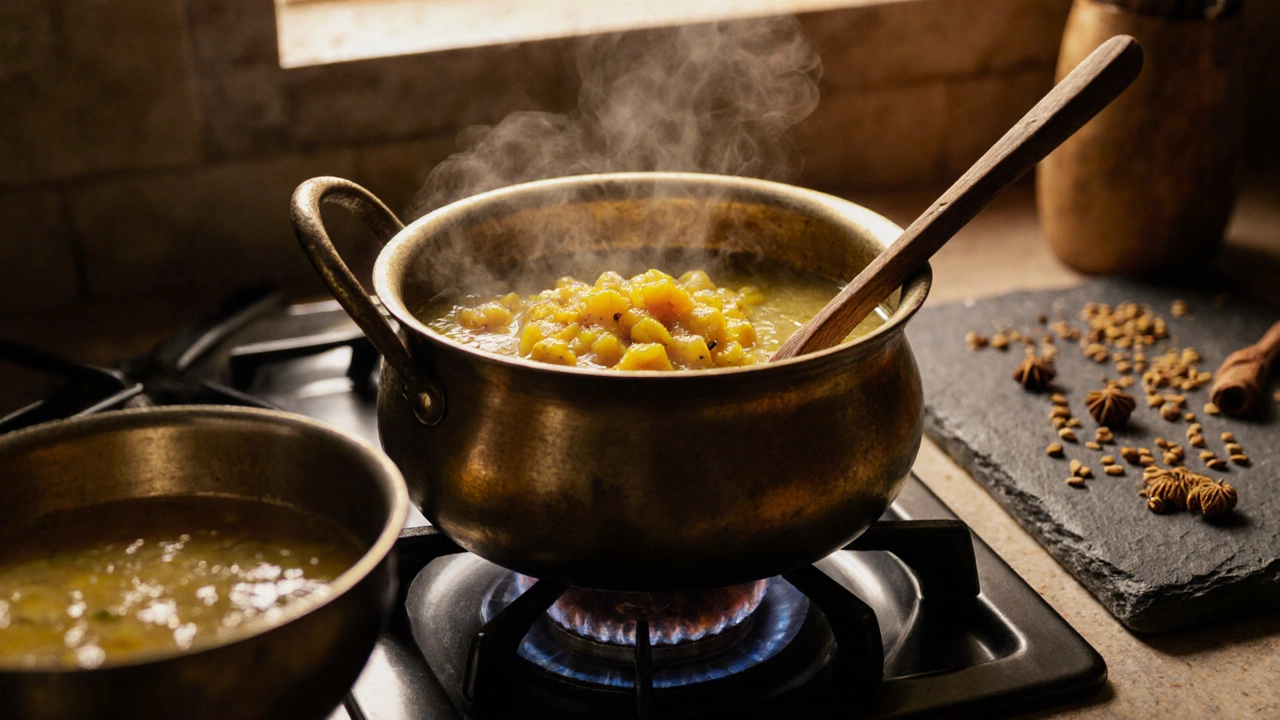Dal Water Ratio Calculator
Enter Your Ingredients
How It Works
This calculator uses the exact ratios from the article to help you cook perfect dal every time. Input your dal type, quantity, and preferences to get your personalized water measurement.
Your Perfect Ratio
Recommended cooking method:
Getting the water to dal ratio right is the difference between mushy, overcooked lentils and dal that’s creamy, flavorful, and just right. Too much water, and your dal turns into soup. Too little, and you end up with dry, undercooked lentils that stick to the bottom of the pot. It’s not complicated, but it’s not guesswork either. The exact ratio depends on the type of dal you’re using, whether you’ve soaked it, and what texture you want-thick and hearty or thin and soupy.
Basic Water to Dal Ratio for Common Types of Dal
Not all dals are the same. Each variety absorbs water differently. Here’s what works for the most popular types:
- Yellow moong dal: 1:3 ratio (1 cup dal to 3 cups water). This cooks fast and breaks down easily, so it needs less water than others.
- Red masoor dal: 1:3.5 ratio. It softens quickly and gives a smooth texture, perfect for everyday dal.
- Chana dal: 1:4 ratio. These split chickpeas are harder and take longer to cook. Don’t skip soaking them overnight if you want them tender in under 30 minutes.
- Toor dal (arhar dal): 1:4 ratio. This is the dal used in most South Indian sambar. It holds its shape better, so it needs more water to fully soften.
- Urad dal (black gram): 1:4 to 1:5 ratio. Whole urad takes ages to cook. Split urad cooks faster, but still needs more water than moong or masoor.
If you’re using unsoaked dal, add an extra half cup of water per cup of dal. Soaked dal absorbs water before cooking, so you don’t need as much during the boil.
Why Soaking Matters
Soaking dal isn’t just a traditional step-it’s a shortcut to better texture and faster cooking. Soaked dal softens before heat even hits it, which means:
- It cooks 20-30% faster
- It’s easier to digest
- You need less water overall
- It reduces the chance of burning or sticking
For most dals, soak for 30 minutes to 2 hours in warm water. Chana dal and whole urad dal benefit from soaking overnight. Drain and rinse before cooking. You’ll notice the difference in texture-no gritty bits, no hard centers.
How to Adjust Based on Your Cookware
The pot you use changes how water behaves. A pressure cooker traps steam, so you need less water. A regular saucepan lets steam escape, so you need more.
- Pressure cooker: Use 1:2.5 ratio for most dals. After the first whistle, reduce heat and cook for 8-10 minutes. Let pressure release naturally.
- Stovetop pot: Use 1:3.5 to 1:4. Bring to a boil, then simmer covered. Stir once or twice to prevent sticking.
- Slow cooker: Use 1:5. Cook on low for 6-8 hours. No stirring needed.
If you’re using an electric rice cooker with a dal setting, follow the manufacturer’s guide. Most recommend 1:3 for split dals.

Texture Matters: Thick vs. Thin Dal
Do you like your dal thick enough to spoon over rice? Or thin, like a broth? The water ratio controls this.
- Thick dal (for khichdi or dal-rice): Use 1:2.5 to 1:3. Let it simmer uncovered for the last 10 minutes to thicken.
- Thin dal (for soup or sambar): Use 1:4 to 1:5. You can always reduce it later by boiling uncovered.
After cooking, if your dal is too thick, add hot water a quarter cup at a time. If it’s too thin, let it simmer uncovered until it thickens. Never add cold water-it stops the cooking process and dulls the flavor.
Seasoning and Tempering: The Final Touch
Water ratio gets you the base. But the flavor comes from the tempering. Heat oil or ghee in a small pan. Add cumin seeds, mustard seeds, dried red chilies, curry leaves, and a pinch of asafoetida. Pour this hot oil over your cooked dal. The sizzle unlocks the spices and ties everything together.
Don’t skip this step. Even the most perfectly cooked dal tastes flat without tempering. It’s not optional-it’s the soul of the dish.

Common Mistakes to Avoid
Here’s what goes wrong-and how to fix it:
- Dal is still hard after cooking: You didn’t use enough water or didn’t soak it. Next time, add more water and soak longer.
- Dal is watery and flavorless: You used too much water or added salt too early. Salt draws moisture out and can toughen lentils. Add salt only after the dal is soft.
- Dal sticks and burns: You didn’t stir enough or used too little water. Use a heavy-bottomed pot and stir once or twice during simmering.
- Dal turns mushy: You overcooked it or used too much water. Reduce cooking time next time and stick to the recommended ratios.
Pro Tips for Perfect Dal Every Time
- Use filtered or bottled water if your tap water is hard. Minerals can make dal tough.
- Don’t rinse dal too much-it washes away nutrients and flavor.
- For extra creaminess, mash a few lentils with the back of a spoon before serving.
- Leftover dal thickens as it cools. Add a splash of warm water when reheating.
- Store dal in the fridge for up to 5 days. It tastes even better the next day.
Once you get the water to dal ratio down for your favorite types, cooking dal becomes automatic. No more guessing. No more ruined batches. Just consistent, comforting bowls of dal that taste like home.
What is the standard water to dal ratio for moong dal?
For yellow moong dal, use a 1:3 ratio-1 cup of dal to 3 cups of water. If you’ve soaked it for 30 minutes, you can reduce it to 1:2.5. This gives you a soft, creamy texture without turning it into soup.
Can I use the same water ratio for all types of dal?
No. Different dals have different densities and cooking times. Moong and masoor dal need less water (1:3 to 1:3.5), while chana dal and toor dal need more (1:4 to 1:5). Always adjust based on the type you’re using.
Should I soak dal before cooking?
Yes, soaking helps. It reduces cooking time by 20-30%, improves digestibility, and prevents the dal from becoming gritty. Soak split dals for 30 minutes to 2 hours. Whole dals like chana dal benefit from an overnight soak.
Why does my dal taste bland even after cooking?
Bland dal usually means the tempering (tadka) was skipped or underdone. Heat oil with cumin, mustard seeds, dried chilies, and curry leaves, then pour it over the cooked dal. The sizzle releases the essential oils and transforms the flavor. Salt added too early can also dull taste-add it after the dal is soft.
How do I fix dal that’s too thick or too thin?
If it’s too thick, stir in hot water, a quarter cup at a time, until it reaches your desired consistency. If it’s too thin, simmer it uncovered for 10-15 minutes to let excess water evaporate. Never add cold water-it stops cooking and makes the dal taste dull.
Mastering the water to dal ratio is the first step to making dal that’s rich, comforting, and deeply satisfying. Once you know how much water each type needs, you’ll stop second-guessing and start cooking with confidence.
